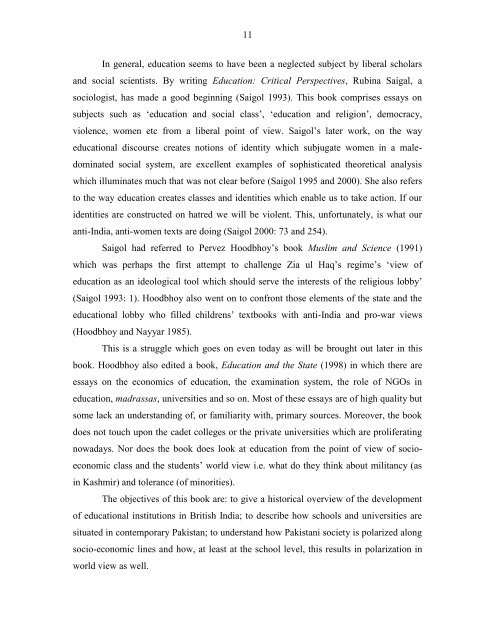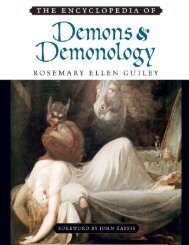DENIZENS OF ALIEN WORLDS
danizen1
danizen1
- No tags were found...
Create successful ePaper yourself
Turn your PDF publications into a flip-book with our unique Google optimized e-Paper software.
11<br />
In general, education seems to have been a neglected subject by liberal scholars<br />
and social scientists. By writing Education: Critical Perspectives, Rubina Saigal, a<br />
sociologist, has made a good beginning (Saigol 1993). This book comprises essays on<br />
subjects such as ‗education and social class‘, ‗education and religion‘, democracy,<br />
violence, women etc from a liberal point of view. Saigol‘s later work, on the way<br />
educational discourse creates notions of identity which subjugate women in a maledominated<br />
social system, are excellent examples of sophisticated theoretical analysis<br />
which illuminates much that was not clear before (Saigol 1995 and 2000). She also refers<br />
to the way education creates classes and identities which enable us to take action. If our<br />
identities are constructed on hatred we will be violent. This, unfortunately, is what our<br />
anti-India, anti-women texts are doing (Saigol 2000: 73 and 254).<br />
Saigol had referred to Pervez Hoodbhoy‘s book Muslim and Science (1991)<br />
which was perhaps the first attempt to challenge Zia ul Haq‘s regime‘s ‗view of<br />
education as an ideological tool which should serve the interests of the religious lobby‘<br />
(Saigol 1993: 1). Hoodbhoy also went on to confront those elements of the state and the<br />
educational lobby who filled childrens‘ textbooks with anti-India and pro-war views<br />
(Hoodbhoy and Nayyar 1985).<br />
This is a struggle which goes on even today as will be brought out later in this<br />
book. Hoodbhoy also edited a book, Education and the State (1998) in which there are<br />
essays on the economics of education, the examination system, the role of NGOs in<br />
education, madrassas, universities and so on. Most of these essays are of high quality but<br />
some lack an understanding of, or familiarity with, primary sources. Moreover, the book<br />
does not touch upon the cadet colleges or the private universities which are proliferating<br />
nowadays. Nor does the book does look at education from the point of view of socioeconomic<br />
class and the students‘ world view i.e. what do they think about militancy (as<br />
in Kashmir) and tolerance (of minorities).<br />
The objectives of this book are: to give a historical overview of the development<br />
of educational institutions in British India; to describe how schools and universities are<br />
situated in contemporary Pakistan; to understand how Pakistani society is polarized along<br />
socio-economic lines and how, at least at the school level, this results in polarization in<br />
world view as well.












